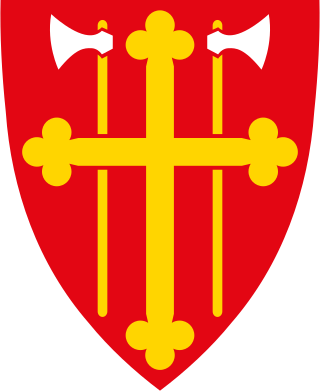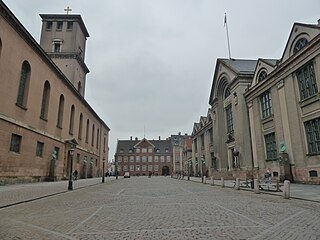
Christian III reigned as King of Denmark from 1534 and King of Norway from 1537 until his death in 1559. During his reign, Christian formed close ties between the church and the crown. He established Lutheranism as the state religion within his realms as part of the Protestant Reformation, and was the first King of Denmark-Norway.

The Church of Norway is an evangelical Lutheran denomination of Protestant Christianity and by far the largest Christian church in Norway. The church became the state church of Norway around 1020, and was established as a separate church intimately integrated with the state as a result of the Lutheran reformation in Denmark–Norway which broke ties with the Holy See in 1536–1537; the King of Norway was the church's head from 1537 to 2012. Historically the church was one of the main instruments of royal power and official authority, and an important part of the state administration; local government was based on the church's parishes with significant official responsibility held by the parish priest.

The Evangelical-Lutheran Church in Denmark or National Church, sometimes called the Church of Denmark, is the established, state-supported church in Denmark. The supreme secular authority of the church is composed of the reigning monarch and Denmark's Parliament, the Folketing. As of 1 January 2023, 72.1% of the population of Denmark are members, though membership is voluntary.

Hans Tausen (Tavsen) nicknamed the “Danish Luther” was the leading Lutheran theologian of the Danish Reformation in Denmark. He served as Bishop of Ribe and published the first translation of the Pentateuch into Danish in 1535.
Poul Helgesen was a Danish Carmelite, a humanist and historian. Helgesen was a mendicant monk who at first supported Christian II and the Lutheran reform movement, but later broke with both and wrote warnings against the tyrannical king and the Lutheran preachers. Like his role model Erasmus of Rotterdam, Helgesen found himself in the gray area between Catholicism and Protestantism.

The Diocese of Copenhagen is a Latin Church ecclesiastical territory or diocese of the Catholic Church named after its episcopal see, the Danish national capital, Copenhagen and covers all Denmark. As in neighbouring provinces, none of the pre-Reformation bishoprics were re-established after Lutheranism became the new official state church in the 16th century). The diocese also covers two Danish overseas possessions, the Faroe Islands and Greenland. It is estimated that 36,000 (0.7%) out of the 5,516,597 inhabitants of the diocesan territory are Catholics.

The Church of Our Lady is the Lutheran cathedral of Copenhagen. It is situated on the Frue Plads public square in central Copenhagen, next to the historic main building of the University of Copenhagen.

Frederik's Church, popularly known as The Marble Church for its rococo architecture, is an Evangelical Lutheran church in Copenhagen, Denmark. The church forms the focal point of the Frederiksstaden district; it is located due west of Amalienborg Palace.

Antvorskov Monastery was the principal Scandinavian monastery of the Catholic Order of Saint John of Jerusalem, located about one kilometer south of the town of Slagelse on Zealand, Denmark.

St. Peter's Church is the parish church of the German-speaking community in Copenhagen, Denmark. It is situated at the corner of Nørregade and Sankt Peders Stræde in the city's Latin Quarter. Built as a single-nave church in the mid-15th century, it is the oldest building in central Copenhagen. It is also notable for its extensive complex of sepulchral chapels.

During the Reformation, the territories ruled by the Danish-based House of Oldenburg converted from Catholicism to Lutheranism. After the break-up of the Kalmar Union in 1521/1523, these realms included the kingdoms of Denmark and Norway and the Duchies of Schleswig and Holstein, whereby Denmark also extended over today's Gotland and Øsel in Estonia.

The Church of the Holy Spirit in Copenhagen, Denmark, is one of the city's oldest churches.

Christianity is a prevalent religion in Denmark; in January 2023, 72.1% of the population of Denmark were members of the Church of Denmark. According to a survey based on a sample 1,114, 25% of Danes believe Jesus is the son of God, and 18% believe he is the saviour of the world. Aside from Lutheranism, there is a small Catholic minority, as well as small Protestant denominations such as the Baptist Union of Denmark and the Reformed Synod of Denmark.

Bispetorv is a small public square in central Copenhagen, Denmark, located on the corner of Nørregade and Studiestræde. It takes its name from the Bishop's House, the official residence of the Bishop of Copenhagen, on the other side of Studiestræde. The square is dominated by the main entrance of Church of Our Lady which faces it on the other side of Nørregade. The Reformation Memorial which stands in the middle of the square is from 1943.

The Church of Greenland, consisting of the Diocese of Greenland is the official Lutheran church in Greenland under the leadership of the Bishop of Greenland. Paneeraq Siegstad Munk became Bishop in 2020.

Frue Plads is a public square located on the north side of the Church of Our Lady in central Copenhagen, Denmark. It occupies a rectangular space which is bounded on the other sides by University of Copenhagen's main building to the north, Nørregade to the west and pedestrianized Fiolstræde to the east.

The equestrian statue of Absalon on Højbro Plads in Copenhagen was unveiled in 1902 to mark the 700 years' anniversary of the death of Bishop Absalon, the city's legendary founder.
The Tranquebar Mission was established in 1706 by two German missionaries from Halle namely, Bartholomäus Ziegenbalg and Heinrich Plütschau. Ziegenbalg and Plütschau responded to the appeal of King Frederick IV of Denmark to establish a mission for the natives, living in the Danish East India Company colony of Tranquebar. The mission was responsible for the printing and publication of the Bible in the Tamil language. In 2006, the 300 years anniversary of the mission was celebrated by the Tamil Evangelical Lutheran Church (TELC), with many international delegates in attendance. A monument to acknowledge 300 years of the mission was raised by the TELC on this occasion.

The Liberty Memorial, located in front of Central Station in Copenhagen, Denmark, is a 20 meter tall obelisque erected in memory of the peasant reforms in 1788 which led to the abolition of serfdom. The 20 metre tall obelisque is made of sandstone from Nexø on Bornholm and its base is made of Norwegian marble. The four female figures at the base of the obelisque symbolise Bravery, Civic Virtue, Fidelity and the Industrious Cultivation of Land.

The Maritime Monument, located at Langelinie, close to Langelinie Marina, is a maritime memorial in Copenhagen, Denmark, commemorating civilian Danish sailors who lost their lives during the First World War. The monument consists of a bronze sculpture of a winged female figure, representing Memory, placed on a rhombus-shaped podium with a series of narrative reliefs on its side.



















